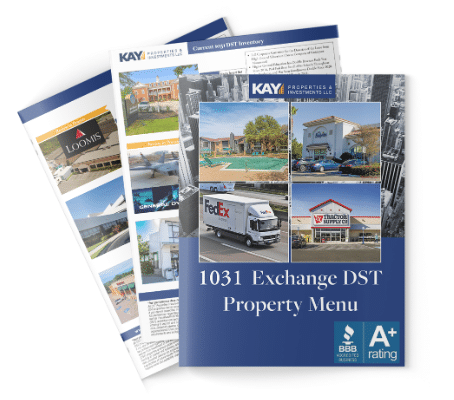What is a 1031 Exchange?
A 1031 exchange is a well-known tax efficient strategy that allows the owner of investment property to defer capital gains taxes by selling and acquiring another “like-kind” investment property. The name comes from IRS Section 1031, and interestingly it has evolved into a kind of eponymic verb within the investment real estate world, as in, “Let’s 1031 this property for that one.”
Listen to Kay Properties and Investments, Executive Vice President and Managing Director, Jason Salmon, describe in detail how the 1031 exchange strategy works in this video.
The trick with the 1031 exchange is that investors must identify a like-kind property with a qualified intermediary (the escrow like company that holds exchange proceeds following the sale of an investment property) within 45 days. From there the investor must close on that property within 180 days of the sale to qualify for the 1031 benefits. In addition, investors must also purchase equal or greater value in replacement properties as they relinquished and reinvest 100% of the net sales proceeds into a replacement property or properties.
This tight timeline and debt replacement requirements can obviously create potential closing risks. Unfortunately, many would be 1031 exchange investors face a potentially failed exchange because they couldn’t close on a piece of property within the rigid IRS timelines or successfully cover their debt replacement requirement. Fortunately, the Delaware Statutory Trust and the www.kpi1031.com marketplace can potentially be a good solution for 1031 exchange investors.
What is a Delaware Statutory Trust?
A Delaware Statutory Trust (DST) is a legal arrangement for real estate ownership where multiple investors jointly own a fractional interest in the real estate assets held by the trust.
One of the potential advantages of DSTs is that because of the fractional ownership structure, many DST 1031 properties have various financing ratios to satisfy an investor’s exchange requirements of taking on “equal or greater debt”. In addition, some DST 1031 properties are also offered with zero leverage, or “debt-free” to mitigate the risk of using financing when purchasing real estate. In addition, the financing used on DST 1031 properties is typically non-recourse to the investor. This means that the lender’s only recourse in the case of a default is the subject property itself. The lender is not able to pursue the investor’s other assets beyond the subject property.
For 1031 exchange investors, this means that Delaware Statutory Trusts can cover the exact amount of debt needed to complete a 1031 exchange. Also, because the DST structure often allows investors to invest as little as $50,000, there is often the opportunity for them to invest in multiple real estate asset classes in multiple locations, and with a variety of tenants. This helps create greater diversification* than investing a substantial amount of an investor’s net worth into a single building. Finally, because Delaware Statutory Trust 1031 properties already have the appraisals, environmental reports, property condition reports, financing, tenant estoppels, etc. in place, investors can typically close on DSTs within three to five business days compared to 30, 60, or 90 days to purchase another outside standard property.
Real Life Example of How One 1031 Exchange Investor Used Delaware Statutory Trusts for Debt Replacement and Portfolio Diversification**
In this real-life scenario, Mr. Jones sold his multifamily apartment building for $2.7million. He also paid off a $946,800 loan on the property representing a 35.07% Loan-to-Value. He now has $1,753,200 in proceeds that will be placed in escrow with a Qualified Intermediary as he attempts to complete his 1031 exchange.
Working with Kay Properties and the www.kpi1031.com marketplace, Mr. Jones not only became fully educated on the Delaware Statutory Trust structure, he also learned about the pros and potential cons of Delaware Statutory Trusts. He learned how DSTs can be a great resource for not only replacing debt but also avoiding over-concentration*.
In this real-life example, Mr. Jones determined he wanted DST properties with rental income potential. He specifically decided to invest $500,000 in one multifamily DST with a $480,392 loan (49% LTV) and $593,610 in a self-storage DST with a $466,408 loan (44% LTV). These investments successfully covered the $946,800 debt he paid off when he sold his original investment property.
Now, because he invested $1,093,610 out of the $1,753,200 in total equity he needed to replace, he decided to invest the remaining $659,590 into two debt-free distribution center DSTs.
As a result, Mr. Jones not only covered his 1031 exchange requirements, he also was able to avoid over-concentration by investing in multiple asset classes with the potential for higher net operating income, and finally, he invested in two debt-free DST properties that will further protect him from any lender recourse.
Kay Properties is an expert at helping 1031 exchange and direct cash investors access quality Delaware Statutory Trust properties. As a result, we have helped thousands of investors complete their 1031 exchanges using the Kay Properties DST marketplace at kpi1031.com. On this platform, investors can review a variety of DST properties that span a wide range of debt levels, from as low as 25% upwards of 70%. Also, for investors that don’t have any debt to replace since they owned their previous property free and clear with no loans, Kay Properties DST marketplace also has debt free DST properties which have no mortgages.
So, it is easy for investors to find options that fit their investment objectives and that can match their equity and debt targets.
**Diversification does not guarantee profits or guarantee protection against losses.

